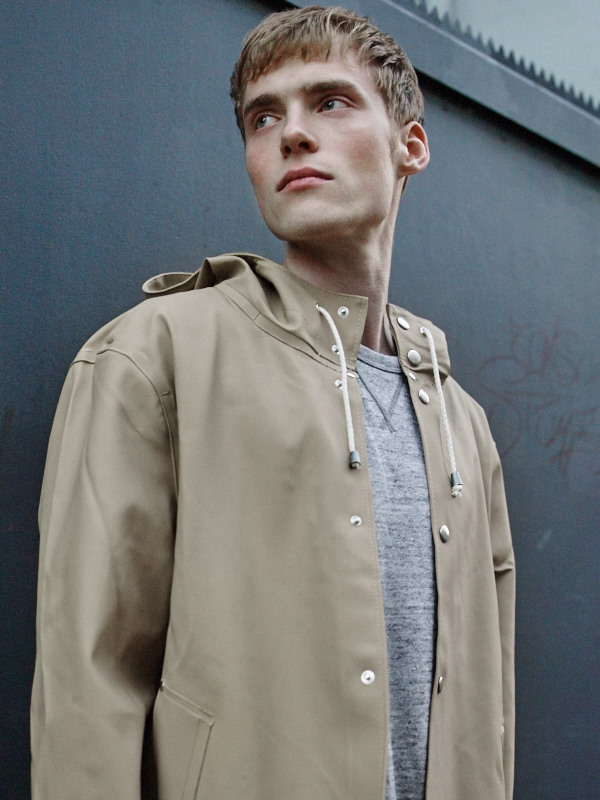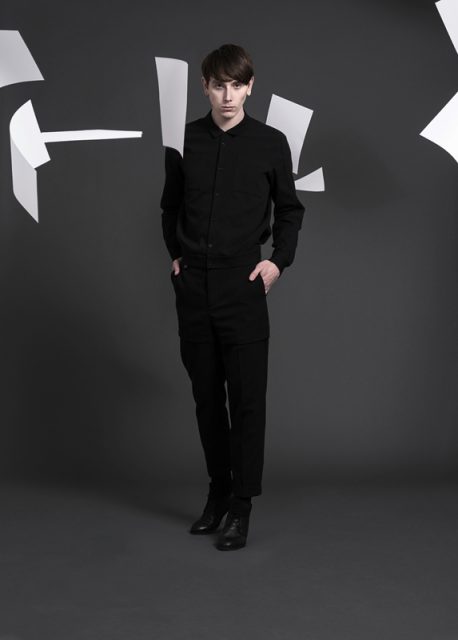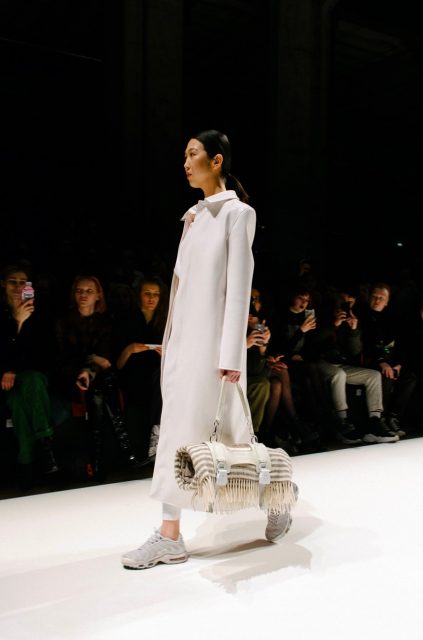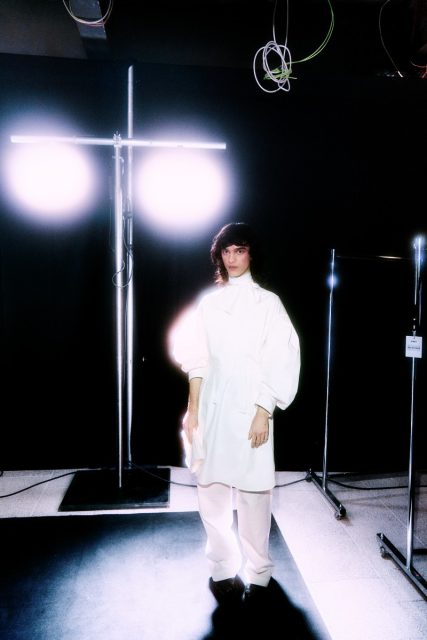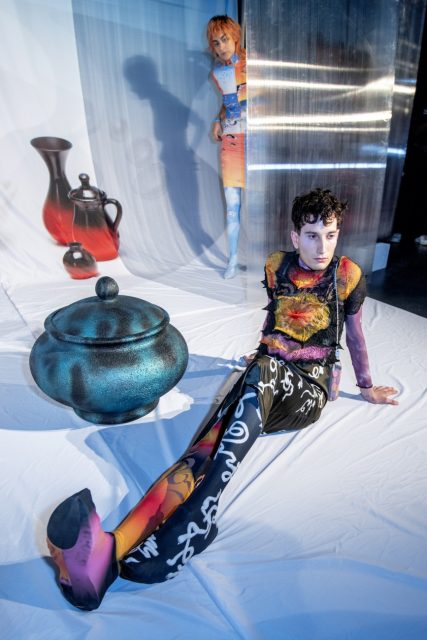
Daniel and Stefano Granzotto of Core Management backstage before Tuesday’s show
Think about all of the men you know who have man buns. Now think about this: in 1979 John Berger wrote an essay called “The Suit and the Photograph” about the photographic work of August Sander. Berger wrote at length about the way in which clothing can embody the spirit and life of the person wearing it. The suit, Berger argued “was made for gestures of talking and calculating abstractly (…) It was a costume which inhibited vigorous action, and which action ruffled, uncreased and spoilt. Horses sweat, men perspire and women glow. By the turn of the century, and increasingly after the First World War, the suit was mass-produced for mass urban and rural markets.”
Yesterday, berlin based designer Daniel Blechman sent his latest collection down the runway for SOPOPULAR. In the same way that suits in the 1900s wrinkled and uncreased according to the actions of the gentlemen who wore them, Blechman’s pieces embody the movability and delicacy of the free-spirited men he designs for. SOPOPULAR’s man is not a suit man, he is urban but rugged, refined but not uptight or precious, he is bold but not flashy, and, as is evidenced by the overwhelming presence of man buns in the show (nearly every model was wearing one), I suggest that SOPOPULAR’s man is a bun man.

RJ Mitte sits in the makeup chair backstage

Model and man bun

PR feet backstage

SS ’16

SS ’16
Blechman’s designs suggested movement, power and uniformity. Much of the fabric was coated with a waxy finish and a slight wrinkle recalling old school Barbour jackets and a kind of “ruffling” Berger would approve of. Shoulders and upper arms were emphasized with cutouts and sleeve garters that evoked old military uniforms. Many of the trousers were cut slightly short, between the ankle and the knee, bringing attention the movements of the leg. The use of drawstrings on many of the pants and jackets was a bit questionable, and brought some of the pants bit too far into yoga territory for my taste. The bunching and swinging of the strings didn’t match the crisp and wispy qualities of the other silhouettes. Shirts were slightly baggy with stiffened collars and tailored shoulders. The balance between militaristic construction and stringy languor, between masculine and feminine was struck consistently throughout the collection. There were starchy construction pants beneath elongated drippy knit sweaters to support them. Fluffy, faux feather vests fluttered over stiff waxy shorts. Blechman’s looks are complex, multi-faceted and fluid, they each contain qualities for those he designs for.

SS ’16
Shortly before Fashion Week madness began, I stopped by Belchman’s studio to talk about his collection, casting, and of course, our dear city.
Can you walk me through how this collection began?
It started with an exhibition I saw in Paris where there were these sculptures made from black strings and I thought I have to do something with strings. I’m also very inspired by Japanese culture and am always inspired by the uniform so we just combined.

A mood board in Blechman’s studio
What are you hoping to convey through the show?
Of course a desire to buy the clothes, that would be the best and for people to see that Berlin can compete internationally. Berlin is still developing, we are not London or Paris but we have the talent and we have possibility to stand out on our own. Stop comparing Berlin to other cities because Berlin has it’s own vibe. Berlin stands for youth culture and it’s edgy and it’s a combination of art of music. We have one of the best club and underground music scenes and this influences how young people are dressing.
Today is casting day. Who are you looking to cast?
Characters. Usually I look for street boys with tattoos and everything, but that’s getting very mainstream. So I like characters, guys with a bit of an edge.
Do you design for the Berlin guy?
No, no. For me, he’s the international guy. He’s fashion forward, he’s at peace with himself. He uses clothes to express himself, not to run after a trend. Of course we want to be trendy and we are, but that’s why I don’t think he’s a Berlin guy, he could be London or Paris.

Blechman looks over a new piece in his studio
How has the Berlin fashion scene changed since you started designing?
When I first started there were very few menswear, and there still are few, but it’s developing. But, we have a lot of problems in Berlin…
Why’s that?
For me, I think fashion is going in the wrong direction. I don’t know if I want to stay in Berlin. I will always be based in Berlin, I love Berlin, but fashion wise I want to show in London, we need to develop. Instead of all working together to make it better, maybe it’s just my impression but I feel there’s a lot of jealousy and people feel ‘if you work with them, then you can’t work with us’. This is not cool.”

SS ’16 croquis

A closeup of a jacket rendering
You lived in London for a while, was the energy different there?
Oh yes. If they discover new talent there, they push you as much as they can. Because it’s a reflection of their whole scene and in Germany it’s different, I feel that there’s this feeling that if you’re too successful they try to knock you down, unless you’re successful internationally. In London, if you’re good in London all the top stores will buy you, but in Germany if you’re good, all the top stores might still buy Scandinavian brands just because it’s cooler.
When did you start conceptualizing this collection?
4 or 5 months ago and as soon as this fashion week is over, we take everything down and we start again.

Literary inspiration
Have you always had the same process for designing a collection?
No, it always develops. Especially because I come with an architecture background, and I had to pay my dues… Do you mind if I smoke a cigarette? Usually I’m not supposed to because of the girls… I work with only girls and they don’t like it.
What is it like working with your team?
I used to not want to hear anything from anybody, but I learned they often have good ideas so now I’m open. I work only with girls. One is my right hand.

Casting snacks
Why did you move from architecture and interior design to fashion?
I always wanted to do fashion, but I studied architecture because my parents wanted me to study something serious.
What did your parents do?
My mom used to be an accountant and my father was a builder, he was a construction worker.
Was it challenging to move from that kind of background into fashion, which can seem so glamorous?
I never thought of it that way. I just thought I want to design clothes. People think it’s glamorous but it’s not. Of course if you’re a big house in Paris it’s glamorous but to get there is a lot of work, a lot of business, a lot of stress.
And now you’re doing your own kind of construction work…?
Exactly.

A mini Daniel sits on a windowsill in the studio
